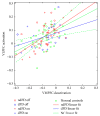Dopaminergic Modulation of Medial Prefrontal Cortex Deactivation in Parkinson Depression
- PMID: 26793404
- PMCID: PMC4697088
- DOI: 10.1155/2015/513452
Dopaminergic Modulation of Medial Prefrontal Cortex Deactivation in Parkinson Depression
Abstract
Parkinson's disease (PD) is associated with emotional abnormalities. Dopaminergic medications ameliorate Parkinsonian motor symptoms, but less is known regarding the impact of dopaminergic agents on affective processing, particularly in depressed PD (dPD) patients. The aim of this study was to examine the effects of dopaminergic pharmacotherapy on brain activation to emotional stimuli in depressed versus nondepressed Parkinson disease (ndPD) patients. Participants included 18 ndPD patients (11 men, 7 women) and 10 dPD patients (7 men, 3 women). Patients viewed photographs of emotional faces during functional MRI. Scans were performed while the patient was taking anti-Parkinson medication and the day after medication had been temporarily discontinued. Results indicate that dopaminergic medications have opposite effects in the prefrontal cortex depending upon depression status. DPD patients show greater deactivation in the ventromedial prefrontal cortex (VMPFC) on dopaminergic medications than off, while ndPD patients show greater deactivation in this region off drugs. The VMPFC is in the default-mode network (DMN). DMN activity is negatively correlated with activity in brain systems used for external visual attention. Thus dopaminergic medications may promote increased attention to external visual stimuli among dPD patients but impede normal suppression of DMN activity during external stimulation among ndPD patients.
Figures





Similar articles
-
Dopaminergic modulation of the default mode network in Parkinson's disease.Eur Neuropsychopharmacol. 2010 Nov;20(11):784-92. doi: 10.1016/j.euroneuro.2010.07.001. Epub 2010 Jul 31. Eur Neuropsychopharmacol. 2010. PMID: 20674286 Clinical Trial.
-
Altered Resting-State Brain Activity and Connectivity in Depressed Parkinson's Disease.PLoS One. 2015 Jul 6;10(7):e0131133. doi: 10.1371/journal.pone.0131133. eCollection 2015. PLoS One. 2015. PMID: 26147571 Free PMC article.
-
Altered Neural Network Connectivity Predicts Depression in de novo Parkinson's Disease.Front Neurosci. 2022 Mar 4;16:828651. doi: 10.3389/fnins.2022.828651. eCollection 2022. Front Neurosci. 2022. PMID: 35310104 Free PMC article.
-
Dopamine receptor agonists and depression in Parkinson's disease.Parkinsonism Relat Disord. 2009 Dec;15 Suppl 4:S81-4. doi: 10.1016/S1353-8020(09)70841-7. Parkinsonism Relat Disord. 2009. PMID: 20123564 Review.
-
Post mortem studies in Parkinson's disease--is it possible to detect brain areas for specific symptoms?J Neural Transm Suppl. 1999;56:1-29. doi: 10.1007/978-3-7091-6360-3_1. J Neural Transm Suppl. 1999. PMID: 10370901 Review.
Cited by
-
Synaptic potentiation of anterior cingulate cortex contributes to chronic pain of Parkinson's disease.Mol Brain. 2021 Nov 6;14(1):161. doi: 10.1186/s13041-021-00870-y. Mol Brain. 2021. PMID: 34742316 Free PMC article.
-
High-Intensity Exercise Acutely Increases Substantia Nigra and Prefrontal Brain Activity in Parkinson's Disease.Med Sci Monit. 2017 Dec 23;23:6064-6071. doi: 10.12659/msm.906179. Med Sci Monit. 2017. PMID: 29273705 Free PMC article.
-
Selegiline Recovers Synaptic Plasticity in the Medial Prefrontal Cortex and Improves Corresponding Depression-Like Behavior in a Mouse Model of Parkinson's Disease.Front Behav Neurosci. 2019 Aug 2;13:176. doi: 10.3389/fnbeh.2019.00176. eCollection 2019. Front Behav Neurosci. 2019. PMID: 31427934 Free PMC article.
-
Cellular and synaptic mechanisms for Parkinson's disease-related chronic pain.Mol Pain. 2021 Jan-Dec;17:1744806921999025. doi: 10.1177/1744806921999025. Mol Pain. 2021. PMID: 33784837 Free PMC article. Review.
-
Altered voxel-level whole-brain functional connectivity in multiple system atrophy patients with depression symptoms.BMC Psychiatry. 2022 Apr 20;22(1):279. doi: 10.1186/s12888-022-03893-4. BMC Psychiatry. 2022. PMID: 35443639 Free PMC article.
References
Grants and funding
LinkOut - more resources
Full Text Sources
Other Literature Sources

